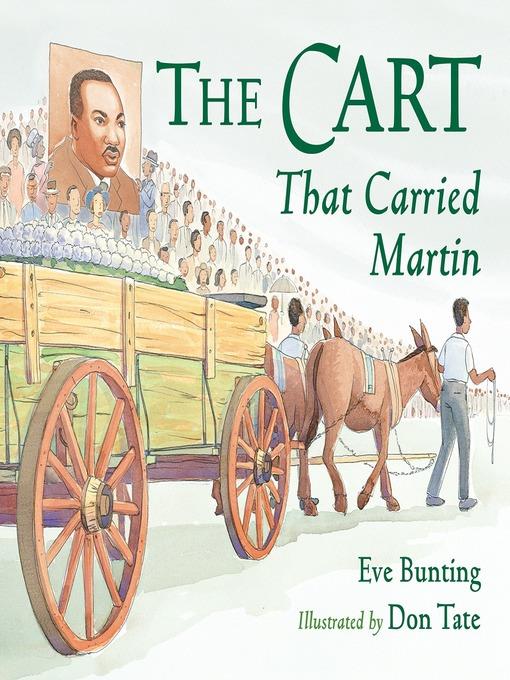
The Cart That Carried Martin
فرمت کتاب
ebook
تاریخ انتشار
2018
Lexile Score
570
Reading Level
2-3
ATOS
3.6
Interest Level
K-3(LG)
نویسنده
Don Tateناشر
Charlesbridgeشابک
9781632897695
کتاب های مرتبط
- اطلاعات
- نقد و بررسی
- دیدگاه کاربران
نقد و بررسی

September 30, 2013
Bunting’s (Have You Seen My New Blue Socks?) impressionistic, dramatic recreation of Martin Luther King, Jr.’s funeral procession covers much of the same ground as Belle, The Last Mule at Gee’s Bend by Calvin Alexander Ramsey and Bettye Stroud (2011). In clipped prose, Bunting writes of the weather-beaten farm cart borrowed for the job (“Its paint had faded.... Nobody wanted it”) and of the thousands who came out to pay final respects: “The church throbbed with the sounds of singing. The songs were not sad, but there was a terrible sadness in them anyway.” Tate’s (Hope’s Gift) loose pencil and gouache art balances emotionally charged close-up images of mourners with broader scenes in which crowds flank the mule-drawn cart on its journey through Atlanta. In a birds-eye view of the scene at King’s alma mater, Morehouse College, a vast, gray sea of people fills the school’s quadrangle for a second memorial service. The final pages reveal the cart’s current home and further emphasize the humility of a vehicle “that, not so long ago, carried greatness.” Ages 6–9. Illustrator’s agent: Caryn Wiseman, Andrea Brown Literary Agency.

November 1, 2013
K-Gr 2-Bunting's quietly sorrowful prose is rather like free-verse poetry, maximizing the power of the story of Martin Luther King, Jr.'s funeral with minimal language. This event needs no adornment; from the soaring hymns sung in Ebenezer Baptist Church to the size of the crowds along the procession route to the humble farm cart that carried King's body, the details of the day speak forcefully to the impact of this man on society. Bunting focuses in particular on the rough-hewn cart, borrowed from a junk store and given a coat of green paint for the procession from the church to Morehouse College. The cart was hitched to a pair of mules and guided through the streets of Atlanta, carrying the civil rights leader's body past thousands of mourners, whose hushed reverence is echoed in Bunting's sparing, soft narrative. Tate also employs a quietness in his artwork. Whereas bold colors would suit a book about King's activism, the soft wash of the illustrations is appropriate to his silenced voice and the stillness of his grieving followers. This beautiful presentation, centered on a humble detail, is a gentle, stirring introduction to what Martin Luther King, Jr.-and his loss-signified.-Alyson Low, Fayetteville Public Library, AR
Copyright 2013 School Library Journal, LLC Used with permission.

August 15, 2013
An old, unwanted cart becomes part of Dr. Martin Luther King's funeral procession. Two men borrow the cart from an antiques store and paint it green, the color of freshly watered grass. They take it to the Ebenezer Baptist Church and hitch two mules to it. Outside the church, crowds gather, while inside, the pews are filled with a weeping congregation. Slowly, the mules pull the cart carrying Dr. King's coffin through the streets of Atlanta to Morehouse College for a second service. The cart, its day's journey completed, is now part of the Martin Luther King Jr. National Historic Site. Bunting uses simple declarative sentences to capture the sorrow of the day and the message that King's followers were intent upon proclaiming--his greatness came from humble beginnings. The mules, Belle and Ada, were a reminder that upon freedom, slaves were given forty acres and a mule. Tate's pencil-and-gouache artwork plays up the details of the cart and the two mules while depicting the crowds of mourners less distinctly. Adults looking for a title to share with young readers will find this helpful in imparting the emotions raised by King's assassination. An affecting snapshot of a tragic day. (afterword) (Picture book. 4-7)
COPYRIGHT(2013) Kirkus Reviews, ALL RIGHTS RESERVED.

Starred review from November 1, 2013
Grades 1-4 *Starred Review* Short on text but long on symbolic meaning and emotional impact, this offers up something far different than a typical biography, with its stunning recollection of Martin Luther King Jr.'s funeral procession through Atlanta. The caisson that carried King's body was a simple wooden cart borrowed from a closed antique store, hastily painted, and attached to two young mules. Disarming in its ordinariness, this cart carried King for three miles, winding its way through the streets of Atlanta to Ebenezer Baptist Church, past the Georgia State Capitol building, where onlookers sang We Shall Overcome, and on to the quad at Morehouse College. Tate's watercolors take on an ever-wider scope as the crowd of mourners swells, but they're worthy of careful attention, too, as details of King's life and work are alluded to throughout. They perfectly complement Bunting's straightforward but elegant narrative; together, they support quite a bit of symbolism while maintaining a strong sense of realism. This inspired title could be the impetus for countless important discussions about Martin Luther King Jr. and the civil rights movement, both of which began small but grew into remarkable historical forces.(Reprinted with permission of Booklist, copyright 2013, American Library Association.)

























دیدگاه کاربران